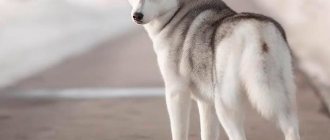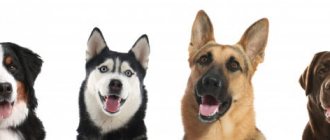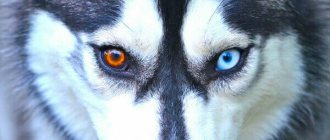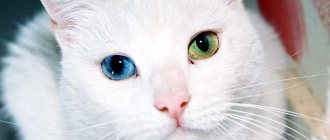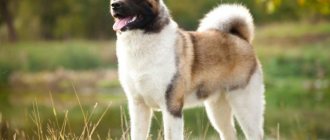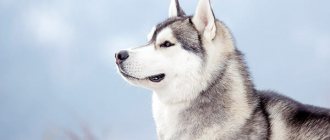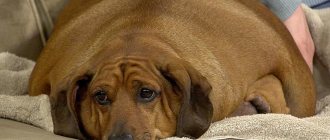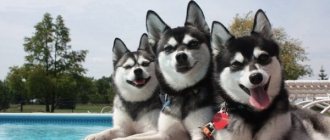These undoubtedly popular and cute dogs attract the attention of animal lovers not only with their soft long hair, pleasant beautiful color and kind, friendly character, but also with their unusual eyes.
The resemblance to a wolf is given by a face frame, or a mask, which can start on the very bridge of the nose and extend onto the forehead. This variety of colors is sure to be found among representatives of the Siberian Husky breed.
The history of the appearance of the Siberian Husky breed
Sled huskies in harness are a common sight in the North.
Husky dogs come from the Far East. Their ancestors are Siberian sled huskies. The breed has been bred since Neolithic times by aboriginal tribes who were engaged in fishing and hunting sea life. Thanks to the endurance and strength of dogs, nomadic peoples were able to move around the northern regions, covering vast distances on sleds.
In the 17th-18th centuries, Russians began to actively develop sled dog breeding. To develop the regions of Siberia, they needed reliable transport for the delivery of goods, mail and the movement of officials. A larger number of dogs were required to transport a new type of capacious sled, and therefore the number of huskies increased.
During the “Gold Rush” era, the demand for sled dogs increased among Americans who visited Alaska, and in 1908 they began to import huskies to the United States for subsequent breeding and participation in racing.
Attention! The dogs showed excellent abilities to overcome difficult distances, and it is impossible to count how many heroic deeds they performed.
For example, in 1925, sled dogs saved human lives from death by delivering needed medicine from a train station to the Alaskan city of Nome, where there was an outbreak of a diphtheria epidemic.
This ancient sled dog breed was registered by American cynologists in 1934.
Breed standards for eye color
The Siberian Husky breed standard provides for a whole “palette” of dog eye colors:
- Brown color. It has the following shade variations: light brown, yellow-brown (amber), dark brown, green (olive).
- Blue. It includes shades: silver-white, gray, amber.
- Heterochromic color (eyes of different colors). It comes in the following combinations: blue-brown, green-brown, amber-brown, gray-blue.
Dogs have different eyes: normal or defective in the breed
Unusual different (heterochromic) eye colors in huskies are allowed by the breed standard, that is, they are not a defect or a deviation. Huskies with different-colored eyes are not only not rejected, but, on the contrary, are highly valued by breeders who breed them. Since such dogs are in great demand among buyers, puppies with this eye feature are often quite expensive. Odd-eyed huskies – “harlequins” – freely participate in exhibitions and arouse the interest of the jury.
Husky with heterochromia is the norm
How to choose a puppy that is completely black
If you decide that you need a black dog, then first you need to decide on the breed. Each has its own characteristics, leading behavioral traits.
It is necessary to carefully check the following indicators:
- pedigree lines of producers that will be completely pure;
- the puppy’s appearance (exterior) should not differ from the standards (they must be studied in advance);
- possible color transition (the brighter the color, the more advantageous it looks).
According to the classification, some breeds are allowed to have small spots. If you do not plan to perform at exhibitions and engage in hereditary selection, then this does not play a big role. With age, the puppy's coat will change to permanent, and may become darker or slightly lighter.
Smooth-haired dogs have fur that fits very tightly to the body and there is no undercoat. For care, you only need a glove with a special rubberized surface. They are easier to wash. Long-haired Wolfies look great with proper care, but they will have to be constantly combed and tidied up using a slicker.
Carefully examine the ears, eyeliner, lips. Incomplete “drawing”, spots, light shades mean culling of the offspring. The claws should be strong, not brittle, with a stable black color.
Depending on the breed, slight deviations in the color of the iris are possible. They should be the same, brown shades. Different colors are not allowed.
Owners are required to know the specifics of caring for the animal and monitor the behavior that is determined by the breed characteristics inherent in nature. If you choose this or that dog, then you need to understand the character, inclinations, and affections.
Heterochromia and its causes
Such an amazing phenomenon in dogs as heterochromia, translated from Greek means “different color”. To put it scientifically, but briefly, heterochromia is a different color coloring of the irises of the eyes. Heterochromic coloring of the iris is very common in purebred Siberian Huskies; it can be hereditary (congenital) or acquired.
- Hereditary. It is transmitted genetically, that is, a dog is born with this feature. The reason why huskies have different eyes is an excess/deficiency of melanin in the body, which is responsible for the intensity of the color. Also, puppies with heterochromia can appear after mating blue-eyed and brown-eyed representatives of the breed.
- Acquired. Occurs against the background of long-term treatment with potent medications or chronic diseases. Heterochromia in this case is a complication.
The effect of heterochromia on the quality of vision of a dog
If heterochromia is genetic in nature, then it only means a unique feature of a particular dog. And if heterochromia suddenly appears in an adult dog, it must be taken to a veterinary clinic for examination to determine the cause.
Important! It has long been proven in veterinary medicine that such a feature as heterochromia does not in any way affect the quality of vision, therefore a husky with different eyes differs from standard representatives of the breed only in its unique multi-colored gaze.
The most common colors of harlequins
There is a legend that thanks to the love between an icy and a hot dog, cute puppies with different eyes were born, one eye of which was colder than the ocean, and the other hotter than fire. Dogs with different eyes have absorbed both icy courage and the warmest kindness of their hearts.
Commonly occurring harlequin iris colors include the following combinations:
- Blue and brown. This combination of iris colors in heterochromic huskies is the most common of all. Occurs in dogs with black and white or gray coat color.
Heterochromia in the blue-brown color combination
- Green and brown. This is not a common occurrence among harlequins, so breeders sell puppies with such hereditary heterochromia at a higher price than pets with a combination of blue and brown colors.
- Amber and brown. Representatives with this combination are considered the most resilient during physical activity. Also, thanks to the amber and brown shades of the husky’s iris, the harlequin does not experience additional fatigue from light.
Heterochromia in amber-brown color combination
- Gray and blue. The husky has the rarest combination of multi-colored eyes. The look of a husky with light eyes seems as piercing as possible due to the fact that the pupil becomes especially noticeable on the light iris. The gray-blue combination causes some discomfort for the dog, since light irises are more sensitive to light. Especially often the dog has to squint on clear winter days, when the rays of the sun are reflected from the snow.
Heterochromia in the color combination “gray-blue”
Features of the suit
The appearance of dogs of this color is, first of all, a light, aristocratic appearance. The dogs are active and love an active lifestyle and walks in the fresh air. They easily find a common language with other animals and are able to act together, for example, in a common team.
Males are rightfully considered stronger and more resilient. They are larger in size and have a more powerful backbone. Females, on the contrary, are more graceful and fragile, but female representatives of this color cannot be called weak.
Huskies are medium-sized animals with very thick hair and a dense undercoat. They have straight ears, and their tail is more like a huge feather. Dogs of average build, and with proper care and feeding regimen, do not suffer from excess weight. But all this is not the main thing when it comes to huskies. After all, the whole world fell in love with dogs not for their size, coat color or feather-like tail. A husky's pupils are a pet's real asset. They fascinate, impress, and sometimes their gaze sends a chill through your skin.
Different iris color
The standard allows other variations.
Green irises
The breed standard allows greenish shades of the iris. The tints of green are more likely to be an olive color, a derivative of amber. The green in a husky's eyes can be seen from certain angles in bright sunshine, but there is no such thing as an iris the color of green grass.
Husky with green eyes
Blue-eyed huskies
Huskies with blue eyes are the most popular among breed lovers. The iris of blue-eyed dogs has a heavenly color and is surrounded by a black rim. The light iris of the blue-eyed representatives of the Husky breed makes the dog’s gaze piercingly threatening and at the same time incredibly attractive. The genetic anomaly resulted from a mutation in the genome that resulted in a lack of pigment in the iris. However, this feature of the dog’s exterior does not in any way affect the quality of their vision.
Interesting! Previously, such a husky appearance was considered a defect, and blue eyes in dogs were explained as a sign of visual impairment.
Blue-eyed husky
Grey eyes
Representatives with gray eyes are not found as often as others. The coat color of gray eyes is usually close to slate and emphasizes the beauty of the husky's eyes. The color of the iris varies from deep dark to very light gray. The rare color of the iris is truly unique; you want to look at them for a very long time.
Gray-eyed husky
Brown-eyed huskies
Dogs with brown eyes have irises ranging from warm honey to black. Due to the rich pigmentation of the iris, its color appears dense and quite bright. The amber tint in brown-eyed dogs looks especially impressive.
Interesting! In different lighting conditions, the eyes may appear orange, red, golden, or even have a greenish tint.
Brown-eyed husky
Silver-white (albino eyes)
Albino husky eyes are colorless, as is their coat. Individuals with albinism are born extremely rarely and have a silvery-white iris. The edges of the snow-white husky's eyelids, outlined as if drawn with a pencil, emphasize the silver-white color of the eyes against the background of an absolutely white coat, which gives the dog's exterior a fabulous look.
Albino husky eyes
Methods for determining eye color in puppies
As a rule, all husky puppies are born with bluish-blue eyes. As the animal grows and develops, the color of the iris will change if the color is not genetically blue.
At what age from birth can a puppy’s permanent eye color be determined?
Husky puppies, like other breeds, are born blind with closed eyelids. Babies' eyes begin to open in the third week of life. After a few days, the retina should already be formed. Most often, both eyes open at the same time, but it also happens that one is a little late. A slight delay is acceptable, because puppies require different amounts of time to develop properly. If the baby's eyes are still closed within three weeks, they should be rinsed with warm, clean water. Redness or swelling of the eyelids should alert the owner, as this is a sign of an inflammatory process, which means the small pet should be urgently shown to the veterinarian.
It is important to know! You should consult a doctor promptly if the puppy is still blind after a month from birth - this is not normal.
By the age of 6 months, the shade of the puppy’s iris begins to change rapidly, this will be especially noticeable in those dogs whose iris color does not remain blue. Thus, what kind of eyes a husky will have throughout its life will become clear no earlier than six months of age.
Do colors change with age?
The color of an adult husky is difficult to predict. The fact is that during the first moults (at 6-10 months) juniors “rebloom” and change color. Whether the original color will remain the same, deepen or become more faded is impossible to predict.
For example, a copper puppy may turn red, while a bright red puppy may turn fawn. The “glasses” that give the look charm may also disappear.
Typically, the color of a husky changes slightly with age: the color fades and becomes less saturated.
Age-related changes in eye color
During a Husky's life, changes in eye color may occur; heterochromia in an adult (over one year old) is called acquired. Often it is an alarming sign that not everything is in order with the pet’s health. In this case, it is recommended to consult a doctor at a veterinary clinic.
Huskies are amazing dogs. Outwardly resembling wolves and howling like a wolf, they are the most good-natured creatures for their owner and even for the people around them. Dogs adore children and other animals; this breed is not prone to aggression. And their eyes look like lenses have been inserted; it’s impossible not to fall in love with them. You can forget the name of a husky dog, but never forget the eyes!
Character
Siberian Huskies are friendly, focused on interacting with people, and love to play with children. Very neat and clean.
The working past remains in the character of Siberian dogs to this day - they are tireless and active, they love to drag heavy objects. When buying a husky, remember: she will never become a lazy sofa dog and will require long walks in constant movement.
A bored husky can turn the owner's home into a haven of chaos with piles of things scattered in the corners, chewed furniture legs and torn wallpaper. The dog hunts with pleasure, but does not bring prey. She has fun with small animals and birds on her own.
